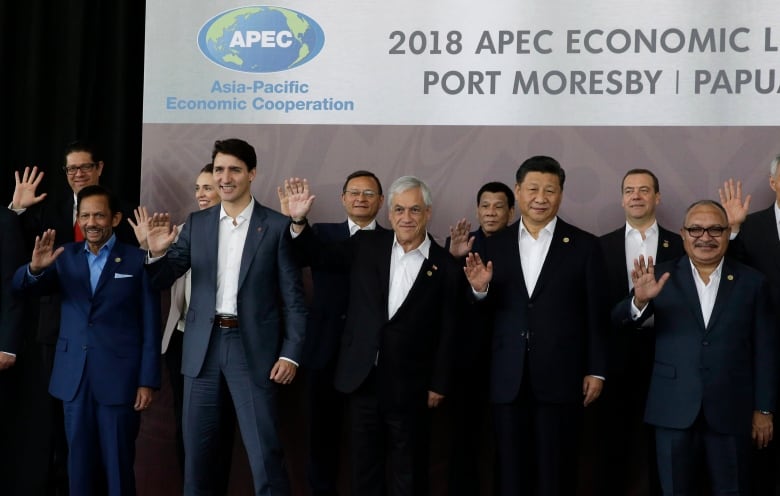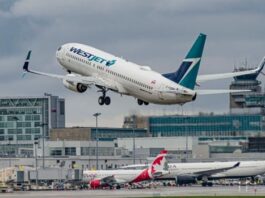
The opening photo call at the Asia-Pacific Economic Co-operation (APEC) summit Saturday turned out to be a useful roadmap for what unfolded in Papua New Guinea’s capital this past weekend.
Front and centre in the shot: Xi Jinping. Stiff and straight, offering an authoritarian smile.
Maybe it was the alphabet that put the Chinese president in the front row (Justin Trudeau was just off-centre, to Xi’s right and the world’s left, with Chile between them.) But it’s a useful visual metaphor, so let’s continue.
Just over Xi’s left shoulder stood Vladimir Putin’s No. 2: Russian Prime Minister Dimitry Medvedev.
Who was missing? Donald Trump’s representative. U.S. Vice-President Mike Pence’s itinerary didn’t prioritize the opening photo.
The leaders carried on without him.

The opening photo call, with China’s Xi Jinping in the front row and U.S. Vice-President Mike Pence absent, served as a sign of things to come at the 2018 APEC summit. (Aaron Favila/Associated Press)
Such was the APEC summit in 2018: the commanding presence of China driving its agenda, with an isolated United States pursuing competing goals, leaving others looking very uncomfortable.
When trade watchers marvel at the failure of this group to come up with even a general consensus statement on a few issues, they do so because this isn’t meant to be a forum for fighting.
Co-operation: it’s right there in APEC’s name.
APEC doesn’t usually get into security issues or high politics, University of British Columbia Asia specialist Yves Tiberghien said.
“This confrontation… as far as I know it was the first time,” he said. “It’s striking.”
Stark contrast to ASEAN
APEC is usually a friendly summit, where the head of the International Monetary Fund offers a briefing and affiliated business advisory councils “engage” politicians on their regional priorities.
Hot for 2018: “strengthening the digital economy” and — in an effort not to look too elite among the Maseratis ferrying VIPs around APEC’s poorest country — enabling “a more open, accessible and secure online environment, so communities and businesses of all sizes can participate.” (Canada was pleased to see an emphasis on digital privacy issues, an official said.)
Many of the leaders, Trudeau included, arrived in Port Moresby from Singapore, the host for the 2018 Association of Southeast Asian Nations (ASEAN) and East Asia Summit talks.
- Analysis
Trudeau heads to ASEAN summit to ‘mend relations’ a year after thorny trade talks
- Analysis
ASEAN summit over, PM Trudeau arrives in Papua New Guinea for APEC summit
The contrast was stark, even jarring: from the luxury fashion labels of a city capitalizing on its region’s fast-growing wealth, to the broken windows and tin roofs of a developing country pushed beyond its limits to host.
Holidays were declared to clear out the city for its international visitors, who were warned not to stop at roadside stands trying to attract the attention, and money, of foreigners.
“This is the biggest thing Papua New Guinea has done in their history,” said Jonathan Pryke, director of the Pacific Islands program at the Lowy Institute, a non-partisan Australian think-tank. The country has “acute development issues,” something Australia has been providing low-key help with for years, particularly in its remote and rural regions.
China winning ‘both above board and below board’
Australia’s support overall dwarfs the Chinese money that flowed into Port Moresby to ensure the summit’s success. But there was nothing subtle about China’s role: a huge Chinese gate outside the brand new Hilton Hotel, with a giant roadside banner celebrating “co-operation” and “peace,” made it pretty obvious who was paying.
Chinese aid is strategic, Pryke says, and usually followed by contracts for China’s state-owned enterprises (SOEs).
“Corruption is a real thing here,” he said. “These SOEs don’t operate on the same playing field as a lot of Western commercial enterprises here. But they’re also competitors. So they are winning contracts both above board and below board.”

China’s presence and influence could be felt throughout Papua New Guinea’s capital city of Port Moresby during the APEC summit. (Mark Schiefelbein/AFP/Getty Images)
Extrapolate that Chinese strategy to a global scale and it gets easier to see what Donald Trump is on about, and why the Americans are so unhappy with the aspects of the World Trade Organization that enable market-distorting, state-subsidized competition.
Fundamental issues stood in the way of a final communiqué at APEC, with some countries wanting reform, and China strenuously objecting to accusations it isn’t playing by the rules laid out when it joined the WTO in 2001.
According to reports from the Australian Broadcasting Corporation, China tried to strong-arm the summit’s host into the language it wanted. No dice.
This disagreement isn’t something that a few more hours, days or weeks of conversation will resolve, despite Xi’s suggestion that multilateralism — talking — is the answer to the escalating trade war that’s slapped hundreds of billions of dollars in disruptive tariffs on the world’s products.
The U.S. may be big enough for a go-it-alone, protectionist strategy, but others — Canada included — are not. Their prosperity depends on trade, and their future economic growth likely requires selling new things to China’s enormous market.
However, their security may depend on continuing to line up with the U.S. So rhetorical demands to pick sides are unwelcome.
Singapore’s prime minister said this week that ASEAN countries need a good working relationship with both China and the U.S. to thrive. The appetite to confront American trade bullying may fade in the face of security concerns, like North Korea’s nuclear program.
‘Coalition in the middle’
The road to the seat of government in Port Moresby was paved by the Chinese. But the warships in its harbour were Australian and American.
Pence turned up at APEC with a commitment to work with Australia to redevelop a naval base on Manus Island to try to counter China’s growing influence in the region.
Beyond the trade war between the U.S. and China, there’s a second confrontation underway about globalization itself, Tiberghien said.
“Clearly there is an interesting clash where the U.S. is saying ‘trade has left too many people behind’ … we have to ‘rein in trade,'” he said.

The tension between the U.S. and China was one of the biggest takeaways from the 2018 APEC summit. (Mark Schiefelbein/Associated Press)
Here the U.S. is not alone: Malaysia, a Pacific Rim trade partner Trudeau also met with this weekend, has voiced similar concerns (and not ratified the Comprehensive and Progressive Trans-Pacific Partnership yet.) So have populist politicians in Europe, including some of the champions of Brexit in the U.K.
It’s a “redrawing of camps,” Tiberghien said.
Trudeau’s father Pierre championed a “third way” foreign policy, hoping to diversify its relationships beyond its Commonwealth history and its geographic ties to the U.S.
Now the son finds himself in need of a third way in trade policy — if the U.S. won’t champion a multilateral trading system anymore, who will? Canada’s working with allies like the European Union, Japan and Australia on how to reinvigorate a rules-based system.
But when the G20 meets in two weeks, the fighting between the two biggest players may suck oxygen away from topics like WTO reforms.
“It’s a very tense environment for making any breakthrough,” Tiberghien said. “But on a secondary level, Canada can show a good image by saying ‘we’re here, we’re reasonable, we stand for principles, we’ll stand with partners that believe in the same principles’ and maybe, over time, build a coalition in the middle.”












